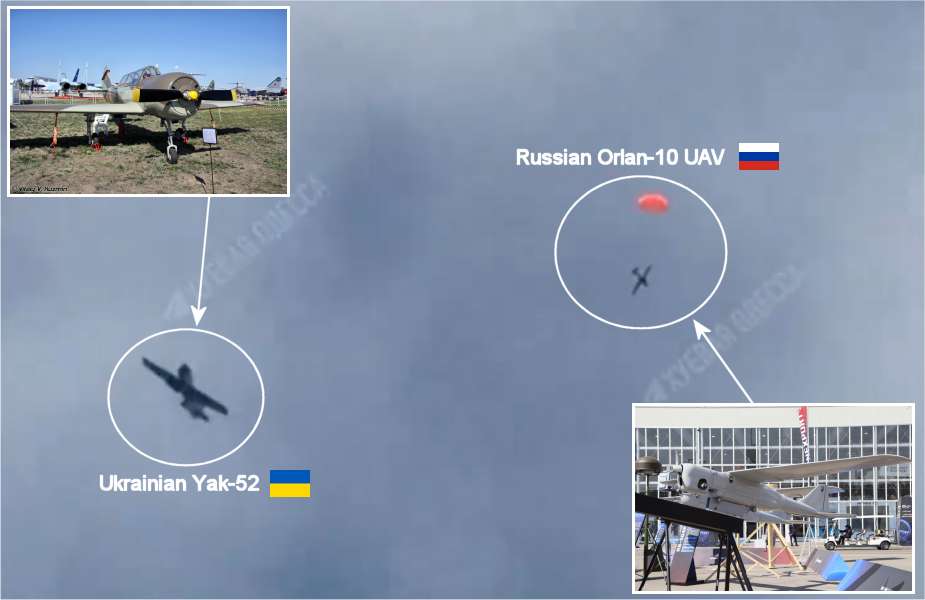Ukraine Shoots Down Russian Orlan-10 UAV with Old Yak-52 Training Aircraft
In a scene reminiscent of World War II aerial battles, a Ukrainian Yak-52 training aircraft reportedly shot down a Russian Orlan-10 drone. On April 27, 2024, reports from various Ukrainian media outlets indicated this rather surprising and anachronistic feat.
Follow Army Recognition on Google News at this link

A Ukrainian Yak-52 training aircraft shoots down a Russian Orlan-10 drone. (Picture source: Vitaly V.Kuzmin / Army Recognition / Social Media)
Footage circulating on platforms like Telegram and X shows the Ukrainian Yak-52 maneuvering near the descending Russian Orlan-10 drone, which appears to be deploying a parachute, likely as a safety measure.
However, the precise method used by the Yak-52 to down the drone remains unclear. Some sources suggest that Ukrainian training aircraft typically lack the necessary modifications to mount machine guns on their wings or fuselage, given the technical complexity involved in such adaptations.
According to Militarnyi, although the Yak-52B variant theoretically retains the ability to carry GUV-8700 pods with machine guns or UB-32 pods with unguided rockets, practical instances of this configuration are rare. Thus, it is likely that the drone was targeted by the second crew member using a firearm or automatic weapon.
The Yakovlev Yak-52 is a training and aerobatic aircraft designed by the Russian manufacturer Yakovlev. It is intended to be piloted by a two-person crew, thus offering a biplane configuration. Making its first flight in 1976, it was officially introduced into service in 1979. The Yak-52 is derived from the Yakovlev Yak-50, sharing characteristics with the latter.
Powered by a Vedeneyev M14P radial engine with 9 cylinders, supercharged by a compressor, the Yak-52 benefits from a total power of 268 kW (360 hp). In terms of performance, it reaches a maximum cruising speed of 230 km/h and a maximum speed of 360 km/h. Its operational range is approximately 550 km.
The aesthetic illustrated by the Yak-52 in flight reflects its versatile role, serving as both a training aircraft for pilots and a platform for aerobatic demonstrations. Its biplane architecture allows for efficient interaction between instructor and student, thereby promoting precise and safe teaching. Additionally, its robust design and dynamic performance make it a popular choice among aerobatics enthusiasts. No doubt this feat of arms will attract even more attention to it.
Powered by a single radial engine Vedeneyev M-14P, the Yak-52 facilitates a tandem positioning between student and instructor pilots, improving communication and training efficiency.
The Orlan-10 is a drone mainly used for reconnaissance and electronic warfare missions. Entered into service in 2011, it is still operational to this day. Designed to operate without a pilot on board, the Orlan-10 is powered by a Saito Manufacturing FA-62B engine, a single-cylinder four-stroke gasoline piston engine.
With an empty weight of 9 kg, the Orlan-10 can reach a total weight of 15 kg when equipped with armaments. In terms of performance, it can fly at a maximum speed of 150 km/h and reach an operational ceiling of 5,000 meters. Its operating range is 110 km/h, with a traversable distance of 600 km. With a flight endurance of up to 16 hours, the Orlan-10 is capable of conducting prolonged reconnaissance missions and gathering essential information over vast territories.
In addition to its primary training role, the Yak-52 has been adapted for light ground attack missions, with some variants equipped to carry machine gun pods or unguided rockets on underwing hardpoints. Its low stall speed makes it suitable for missions like the reported interception over Ukraine on April 27, 2024.

View from inside the Ukrainian Yak-52. (Picture source: Open source information)
Defense News April 2024























